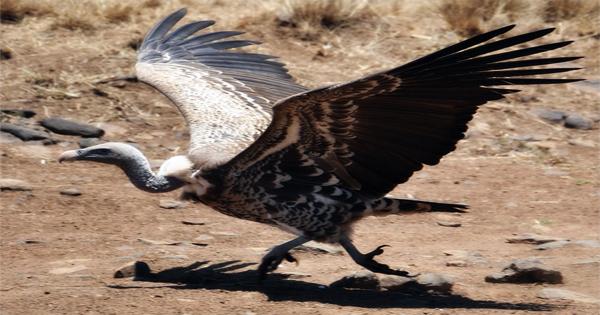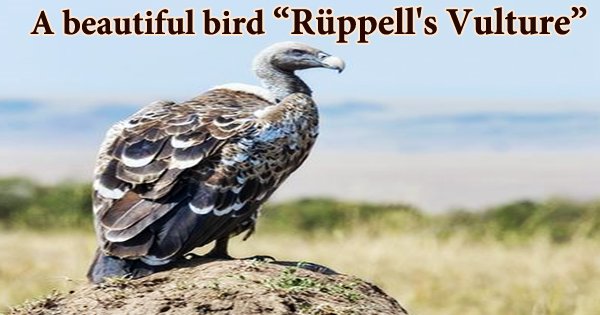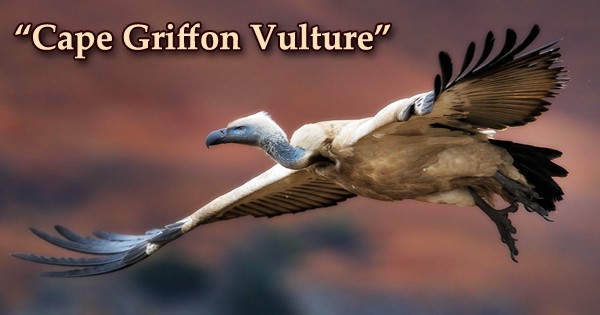The world’s highest-flying bird is the Rüppell’s vulture (Gyps rueppelli), sometimes known as the Rüppell’s griffon vulture after Eduard Rüppell. This critically endangered species is crucial to Africa’s ecology, flying large distances to consume carrion and maintain healthy ecosystems. Due to habitat loss, accidental poisoning, and other factors, the present population of 22,000 is declining. These vultures have been known to soar to heights of more than 36,000 feet (10,973 meters) above sea level. This species’ ability to fly so high is due to a change in one of its proteins, which permits the bird to fly efficiently despite decreased pressure and oxygen availability. It is not to be mistaken with a distinct species, the griffon vulture, which is also known as Rüppell’s griffon, Rueppell’s griffon, Rüppell’s griffin vulture, Rueppell’s vulture, and the griffon vulture (Gyps fulvus). Eduard Rüppell, a 19th-century German naturalist and explorer, gave them their name. They nest in colonies of roughly 100 pairs in a hilly setting because they are gregarious birds. They are scavengers who solely eat carcasses and other dead animals’ remains. The fact that they don’t hunt isn’t due to sloth or frailty; these birds can soar to amazing heights in quest of carrion, and they hold the world record for soaring higher than any other bird. They can be found in grasslands, mountains, and woods throughout the Sahel area and East Africa. Rüppell’s vultures, which were once numerous in these environments, are now in sharp decline, especially in the western part of their range. This vulture is a huge species of vulture, measuring roughly 1 m (3.3 inches) in length, 2.6 m (8.5 foot) in wingspan, and weighing between 7 and 9 kg (15 – 20 lbs). Both males and females have a brown or black overall appearance with a white underside, wispy fluff covering the head and neck, and a white-collar. Eyes are normally amber to yellow in color. They have exceptionally powerful, pale beaks. They are slow-moving birds, traveling at 35 km/h (22 mph), yet they fly for 6–7 hours per day and will go as far as 150 km (93 mi) from their nest location in search of food. Their plumage is mottled brown or black, with a pale brown underbelly and white fluff on the head and neck. They have a white-collar at the base of their necks, and a deep brown crop patch. Their eyes are yellow or amber in color, and they have exceptional vision. They hunt for food only with their eyes, and when they find a carcass, they circle overhead to notify other vultures to their discovery. Their beaks are exceptionally powerful, and their tongues contain backward-facing spines to help them feed.

Rüppell’s vultures are nocturnal and highly sociable birds that roost, breed, and feed in big groups. They are silent, like other vultures, except when they are nesting or hunting near a carcass. They spend a lot of time flying, either gliding with their wings level or employing slow, powerful wing strokes. Rüppell’s vultures can be found flying at heights of up to 6,000 meters (20,000 ft). The birds have a unique hemoglobin alpha subunit that has a high affinity for oxygen, allowing them to absorb oxygen efficiently despite the low partial pressure in the upper troposphere. These vultures hunt for food solely by sight, and when they spot a carcass, they swoop down, land a short distance away, and then leap forward, wings wide and long neck outstretched. As the birds try to grab their prey, fights with other vultures are common. Their necks typically turn deep red from hostility as they hiss, grunt, and chatter at their opponent. Rüppell’s Vultures fly at a cruising speed of 35 km/hr (22 mph) and can reach heights of 6,000 m (20,000 ft) when in flight. They hold the record for being the highest-flying bird, as a Rüppell’s Vulture collided with an aircraft at a height of 11,300 meters above (37,000 ft) Côte d’Ivoire on one occasion. These vultures can be found throughout Africa’s Sahel area, from Senegal, Gambia, and Mali in the west to Sudan, South Sudan, and Ethiopia in the east. In Kenya, Tanzania, and Mozambique, they can be found in the savanna. Because breeding often necessitates a cliff face, Rüppell’s griffon vultures like to be near mountains, but they will also move across woodlands and meadows in search of food. Rüppell’s vultures are monogamous and create deep lifelong relationships with their partners. A couple of vultures will circle close together near cliffs during courtship. Pairs perch for extended periods of time near to each other, eventually forming colonies of up to 1,000 breeding pairs. They line their enormous nests with grass and leaves and make them out of sticks. They have a particularly robust physique, and after devouring the most appealing soft parts of a cadaver, they will continue to gorge themselves on the hide and even the bones, until they can hardly fly. They have spikes on their tongue that point backward to aid in the removal of meat from the bone. In 20 minutes, a group of vultures can clean up the remains of an antelope. Rüppell’s vultures build a platform of sticks and grass on an exposed ledge to lay a single egg, which they do every year after the wet season. Trees can also be used as a nesting site on occasion. Over the course of 55 days, both parents share in the incubation of their egg. When the chick hatches, both parents will feed and care for it until it is ready to fly, which will take roughly 150 days. Rüppell’s griffon vultures have a life expectancy of 40 to 50 years. This once-common species has declined rapidly across much of its range, particularly in West Africa, and is now primarily restricted to protected areas. This vulture is currently designated as an Appendix II species under the CITES (shorter name for the Convention on International Trade in Endangered Species of Wild Fauna and Flora, also known as the Washington Convention), which governs the international trade of animals and plants. These birds have long been associated with black magic in West Africa.
















